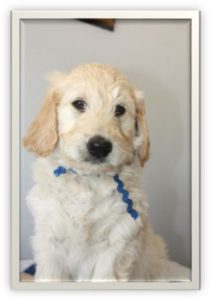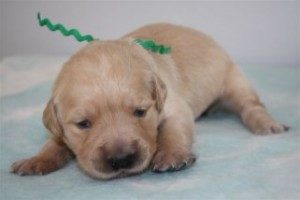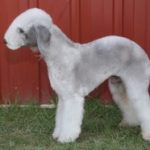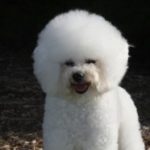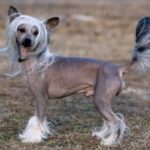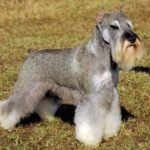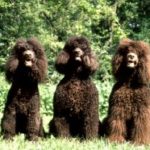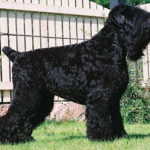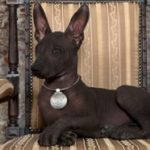Golden doodles: about the breed
Golden doodles are an amazing breed, a cross between a Poodle and a Golden Retriever, they benefit greatly from Hybrid Vigor. Combining these two breeds creates a devoted, gentle and fun-loving companion that is friendly, energetic, and affectionate.
Simply put, nature loves diversity, and because there is little in common between the bloodlines of retrievers and poodles, you get ‘fresh’ genes from either side, and the doodles get the best of both worlds. One of the few things the two breeds do share is high intelligence, which makes golden doodles exceptionally smart.
The English Golden doodle also referred to as Teddy Bear Golden doodles are considered one of the most popular Designer Dogs today. There’s a reason – With their health, even temperaments, hypoallergenic coats, and adorable appearance, they are not only the perfect family pets, they are also the cutest puppies on the planet!!
- Golden Retriever puppy- age 6 weeks
- Golden Doodle puppy- age 6 weeks
- Golden Doodle puppy- age 6 weeks
- Golden Retriever puppy- age 2 weeks
Golden doodles: a bit of history
Golden doodles were first bred in the mid 1990’s. Many smaller poodle mixes had become very popular, and the Golden doodle was bred to provide a larger version of an allergy friendly, light to non-shedding dog. The popularity of the Golden doodle grew quickly as the dogs became known for having the wonderful Golden temperament but not the same amount of shedding. Some breeders went on to breed first cross Golden doodles back to poodles to produce backcross Golden doodle puppies for those who needed a definite non-shedder and definite allergy friendly coat. Golden doodles have not developed beyond this, but there are some who are pursuing developing a multi-gen Golden doodle and hope to have it recognized someday as its own breed.
Designer Dogs?
What does it mean to be a Designer Dog? Does it mean that they are owned by Celebrities? Are they a passing fad? Does it mean you can carry them in your purse?
The term Designer Dogs has only been around within the last decade. Basically, it describes “intentionally breeding two different breeds of purebred dogs to obtain desired results.” The term for this is Hybrid Dogs.
There are a lot of stigmas that go along with Designer or Hybrid Dogs.
Terms like Puppy Mills are often labelled alongside in an effort to discredit legitimate cross-breed breeders, a fact all purebred breeders must admit, where do the purebreds come from??
For instance our Golden Retriever originated as a mix of:
Water Spaniel
Retriever
Irish Setter
Bloodhound
St John’s Waterdog
Or our Black Russian Terriers a mix
Giant Schnauzer
Rottweiler
Airedale Terrier
Newfoundland
Now if that’s not a “mutt”, what is? Much like the creation of any new breed, intentional breeders choose desired traits that appear in puppies, and continue breeding with dogs of other desired traits to produce desired puppies.
What breeders of Hybrid Dogs have figured out is that the most ideal traits are showing up right from the first generation of puppies. True, there may be differences in size, coat type, and level of how Hypoallergenic they are. What is consistent though, is that the temperament AND health of the cross-bred dogs is increased from both lines of the parents in the first crossed generation. This is called Hybrid Vigor.
There are two lines of breeders in the world of Designer Dogs. One line breeds “the true Hybrid”, and the other line works to create a “new breed”. The new breed dogs are usually created by breeding two crossbred dogs of the same breeds together. These puppies are typically called “multigens”.
If you are trying to understand what the letters and numbers mean beside hybrid dog names, here’s a shortlist:
F1 means First Generation. A purebred mother and father from different dog breeds bred together. ( Golden Retriever x Poodle = F1 Golden doodle )
F1b means First Generation Backcross. One parent is an F1; the other is a purebred dog from one of the same breeds as the mother. ( F1 Golden doodle x Poodle = F1b Golden doodle )
F2 means Second Generation. Both parents are F1s
F2b means Second Generation Backcross. One parent is an F2; the other parent is a breed from further up the line (either an F1, or a purebred.)
After this, you may find some breeders labelling with F3 or F4. Otherwise, any level is called a multigen meaning multi-generational.
Often, these dogs are created by having a poodle cross with whichever breed they are working with. Poodles have hypoallergenic qualities. Large portions of the population who have allergies to dogs are able to be around poodles. This may be the reason there are so many Designer Dog Breeds out there.
Once again, hypoallergenic is another term attempting to be discredited. True, there is no dog out there that SOMEONE is not allergic to. That is not what hypoallergenic means. Please learn more about this great phrase and what it can mean to you ( Hypoallergenic )
So what makes a Designer Dog different from a standard cross breed? The first step is to have a successful cross breed. This would mean the puppies have desirable traits, and those traits are reproducible. The second step is having those puppies be desired by the general public
The question that may be asked is “What use is a breed of dog if it doesn’t meet some need in mankind?”
Whether it is for service, guide dog, dog sports, companionship, protection, or friend, any successful breed finds its role in the human world. With being excellent service dogs, companions, and family friends, Designer Dogs really are claiming a starring role all over the word, and way should South Africa get left behind?
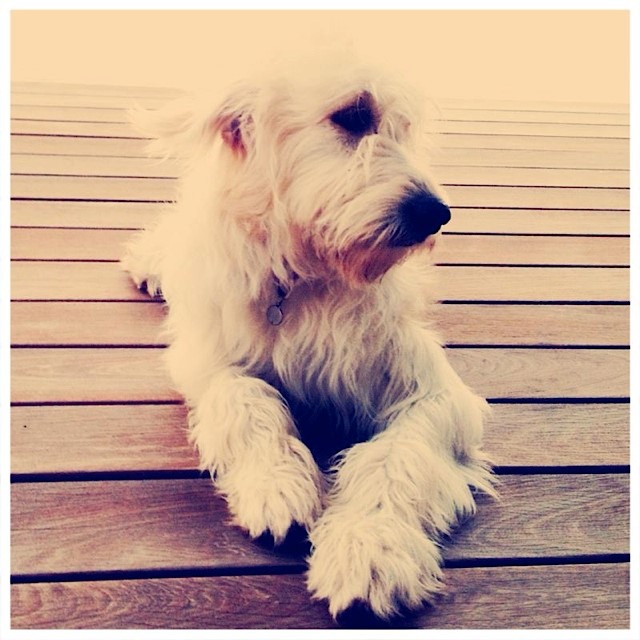
GOLDENDOODLES AS TEENAGERS
Hypoallergenic Dogs?
There is no such thing as a complete hypoallergenic dog breed, although some breeds may cause fewer allergy symptoms than others none of them is completely allergy free. Many people think that pet allergies are caused by a dog’s or cat’s fur, but the real source of pet allergies is often a protein that’s in the saliva and urine of dogs and cats. This protein sticks to the dead, dried flakes (dander) from your pet’s skin. Some dog breeds, such as the soft-coated wheaten terrier, or mixed breeds such as the golden doodle, are marketed as hypoallergenic dogs because they don’t shed fur or they shed very little. Because these dogs don’t shed, the allergy-causing dander that sticks to their fur doesn’t get released into the air or onto the floor as much as it would with a shedding dog. While you may have fewer allergy symptoms with a so-called hypoallergenic dog than with a shedding dog, no dog breed is completely hypoallergenic
The following breeds generally do well with people with allergies,
This list is based on breeds which usually produce less dander.
images courtesy of http://www.akc.org/breeds
(Hover over dog to see caption)
- Bedlington terrier.
- Bichon frise
- Chinese_crested
- Schnauzers (Min, Std, Giant)
- Maltese
- Irish water spaniel
- Portuguese water dog
- BlackRussianTerriers
- Xoloitzcuintli
- Poodle (Toy, Min, Std)
- Soft coated wheaten terrier
- Kerry blue terrier
If you don’t fancy one of the above then why not a get a loving……
English Teddy Bear Golden doodle?


